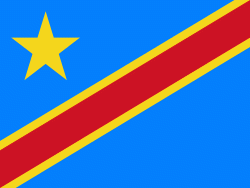Ituri Interim Administration (Ituri)
The Ituri Interim Administration is an interim body that administers the Ituri region of the Democratic Republic of Congo (DRC). It was established in 2003 by the Ituri Pacification Commission and supported by the UN mission in the DRC.
Ituri District was created by an arrêté royal of 28 March 1912, which divided the Belgian Congo into 22 districts. Ituri, as Kibali-Ituri, was a province of the DRC from 1962 to 1966. Prior to the adoption of the 2006 Constitution of the Democratic Republic of the Congo, the legal status of Ituri was a topic of some dispute. From the beginning of the Second Congo War in 1998, it was held by soldiers of the Uganda People's Defense Force (UPDF) and the Ugandan-backed Movement for Liberation faction of the Rally for Congolese Democracy (RCD-ML). In June 1999, the commander of UPDF forces in the DRC, Brig. Gen. James Kazini, ignored the protests of RCD-ML leaders and re-created the province of Kibali-Ituri out of the eastern section of the northeastern Orientale Province. It is almost always referred to simply as Ituri. The capital was Bunia. The creation of a new province under the governorship of a Hema contributed to the start of the current Ituri conflict, that has caused thousands of deaths. Most official cartographers did not include the new province, and those referring to it as a "province" rather than a "region" were sometimes viewed as having a pro-Uganda bias. With the new constitution, Ituri's status as a proposed province was finally settled.
The current Ituri Interim Administration was formed through the efforts of the Ituri Pacification Commission, a commission sponsored by the United Nations Organization Mission in Democratic Republic of the Congo (MONUC, abbreviation of the French name "Mission de l'Organisation des Nations Unies en République Démocratique du Congo") that was set up, after much initial delay, in 2003 after the pull-out of Ugandan troops from the district. It led to the creation of the Ituri Interim Assembly, which elected an administrator and an assembly chairperson; the current assembly chairperson is Petronille Vaweka, who is also the sole deputy for the district to the National Assembly in Kinshasa.
The district is currently recognized as a district of Orientale. The Interim Assembly will be reconstituted or replaced by a provincial assembly under the 2006 constitution. An election for the governor and vice-governor will also be held, and the district will be re-created as a province of the DRC.
Ituri District was created by an arrêté royal of 28 March 1912, which divided the Belgian Congo into 22 districts. Ituri, as Kibali-Ituri, was a province of the DRC from 1962 to 1966. Prior to the adoption of the 2006 Constitution of the Democratic Republic of the Congo, the legal status of Ituri was a topic of some dispute. From the beginning of the Second Congo War in 1998, it was held by soldiers of the Uganda People's Defense Force (UPDF) and the Ugandan-backed Movement for Liberation faction of the Rally for Congolese Democracy (RCD-ML). In June 1999, the commander of UPDF forces in the DRC, Brig. Gen. James Kazini, ignored the protests of RCD-ML leaders and re-created the province of Kibali-Ituri out of the eastern section of the northeastern Orientale Province. It is almost always referred to simply as Ituri. The capital was Bunia. The creation of a new province under the governorship of a Hema contributed to the start of the current Ituri conflict, that has caused thousands of deaths. Most official cartographers did not include the new province, and those referring to it as a "province" rather than a "region" were sometimes viewed as having a pro-Uganda bias. With the new constitution, Ituri's status as a proposed province was finally settled.
The current Ituri Interim Administration was formed through the efforts of the Ituri Pacification Commission, a commission sponsored by the United Nations Organization Mission in Democratic Republic of the Congo (MONUC, abbreviation of the French name "Mission de l'Organisation des Nations Unies en République Démocratique du Congo") that was set up, after much initial delay, in 2003 after the pull-out of Ugandan troops from the district. It led to the creation of the Ituri Interim Assembly, which elected an administrator and an assembly chairperson; the current assembly chairperson is Petronille Vaweka, who is also the sole deputy for the district to the National Assembly in Kinshasa.
The district is currently recognized as a district of Orientale. The Interim Assembly will be reconstituted or replaced by a provincial assembly under the 2006 constitution. An election for the governor and vice-governor will also be held, and the district will be re-created as a province of the DRC.
Map - Ituri Interim Administration (Ituri)
Map
Country - Democratic_Republic_of_the_Congo
 |
 |
| Flag of the Democratic Republic of the Congo | |
Centered on the Congo Basin, the territory of the DRC was first inhabited by Central African foragers around 90,000 years ago and was reached by the Bantu expansion about 3,000 years ago. In the west, the Kingdom of Kongo ruled around the mouth of the Congo River from the 14th to 19th centuries. In the northeast, center and east, the kingdoms of Azande, Luba, and Lunda ruled from the 16th and 17th centuries to the 19th century. King Leopold II of Belgium formally acquired rights to the Congo territory in 1885 and declared the land his private property, naming it the Congo Free State. From 1885 to 1908, his colonial military forced the local population to produce rubber and committed widespread atrocities. In 1908, Leopold ceded the territory, which thus became a Belgian colony.
Currency / Language
| ISO | Currency | Symbol | Significant figures |
|---|---|---|---|
| CDF | Congolese franc | Fr | 2 |
| ISO | Language |
|---|---|
| FR | French language |
| KG | Kongo language |
| LN | Lingala language |















